Once upon a time, in a faraway land, there was a King who had seven sons. Six of his sons got married, but the youngest son didn’t want to get married. Plus, he didn’t like his six sisters-in-law (his brothers’ wives) and wouldn’t even eat food they gave him! This made the sisters-in-law super mad, and one day they teased him, “We bet you’ll marry a Bél-Princess!”
The young prince thought to himself, “A Bél-Princess? What’s that? And where do you find one? I’m going to go look for her!” But the next day, he wondered, “How am I supposed to find a Bél-Princess? I don’t even know where to start!”
Finally, one day, he put a saddle and bridle on his dad’s best horse. He put on his fanciest clothes, grabbed his sword and his toy gun, and said, “Bye, Mom and Dad!” He set off to find the Bél-Princess. His parents were so sad to see him go.
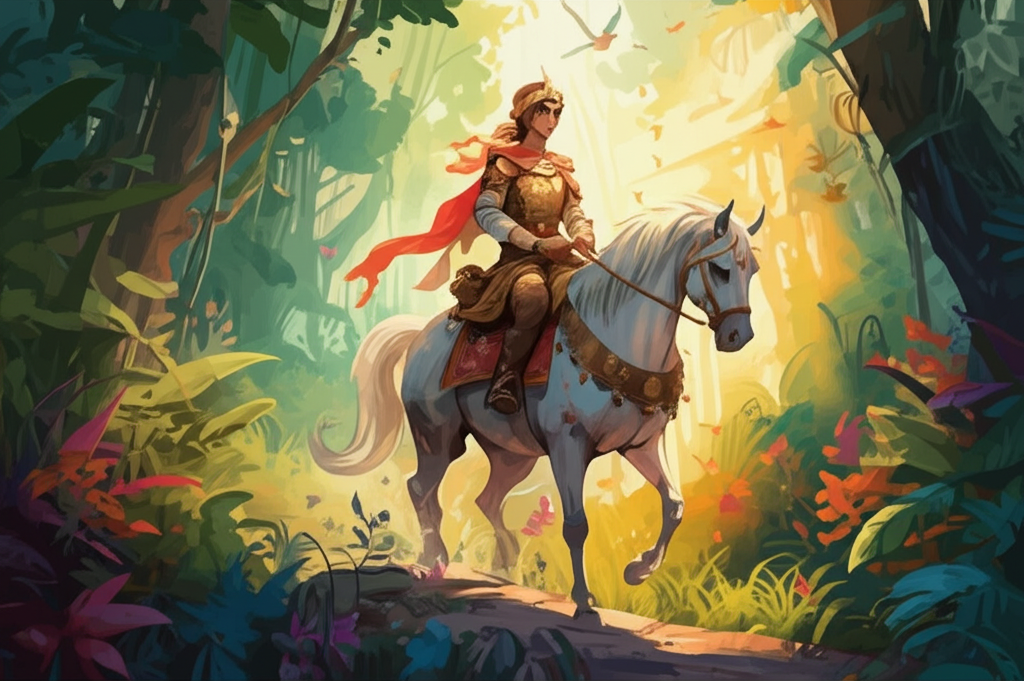
He rode and rode and rode, super far away from his dad’s kingdom. After about six months of traveling, he ended up in a big, scary jungle. He went through the jungle for many days and nights until he found a sleepy fakir (like a wise, magical person) napping. The young prince thought, “I’ll stay with this fakir until he wakes up. Maybe he can help me!” So he stayed with the fakir for a whole month, taking care of him and keeping his little house clean.
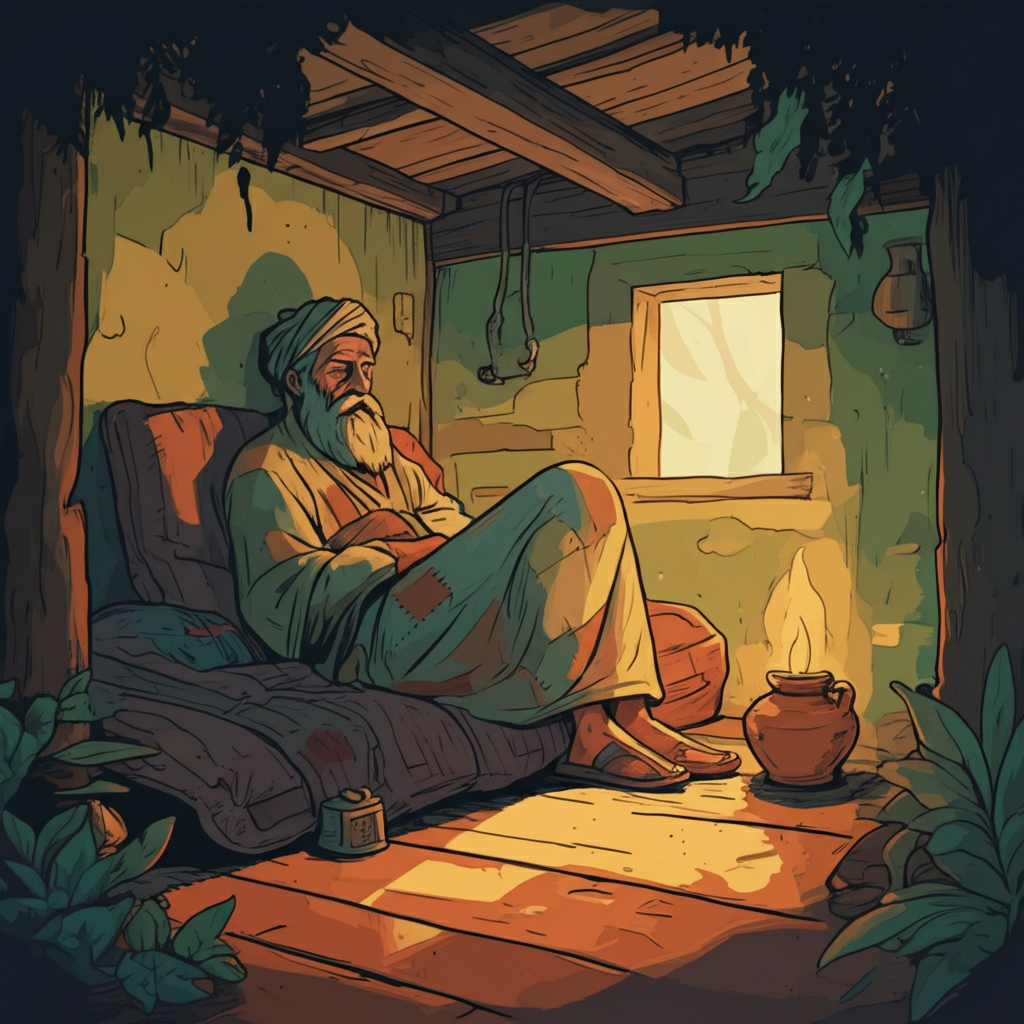
This fakir was a super sleeper! He would sleep for six months straight and then be awake for six months.
After the prince watched over him for a month, the fakir woke up. He was really happy to see how nicely the prince had taken care of him and how clean his house was. He said, “How did you even get to this jungle? Nobody can get here! Who are you, and where are you from?”
“I’m a King’s son,” the prince replied. “My dad’s country is six months away from here. I’m looking for a Bél-Princess. I heard there’s one, and I want to find her! Do you know where she is?”
“Yes, there is one,” the fakir answered. “I know where she lives. She’s in the land of the fairies, and no person can go there!”
This made the young prince really sad. “Oh no!” he cried. “I left my mom and dad and traveled super far to find the Bél-Princess! Now you’re telling me I can’t go where she lives!”
“Don’t worry, I’ll help you,” the fakir said. “If you do exactly what I say, you’ll find her. But first, stay here with me for a little longer.”
So, the King’s son stayed with the fakir for another month, taking care of him and doing everything for him, just like he would for his own dad.
At the end of the month, the fakir gave him his walking stick and said, “Okay, now you have to go to the fairies’ land. It’s a week’s journey from here. When you get there, you’ll see lots of demons and fairies living there.” Then, the fakir took some dirt from the ground and put it in the prince’s hand. “When you get to the fairies’ land, blow this dirt off your hand so the fairies and demons can’t see you. Then you’ll be invisible! Ride until you see a big open field in the middle of their garden. In that field, there’s a big bél-tree with one big bél-fruit hanging on it. The Bél-Princess is inside that fruit! Throw my stick at the fruit to knock it down, but be super careful to catch the fruit in your blanket! Don’t let it fall on the ground! Then, ride back to me as fast as you can. As soon as the fruit falls, you won’t be invisible anymore, and all the fairies and demons guarding the fruit will come chasing after you. They’ll yell at you, but don’t, don’t look behind you! Ride straight to me with the fruit and don’t look back. If you do, you’ll turn into stone, your horse will too, and they’ll take the bél-fruit back to the tree!”
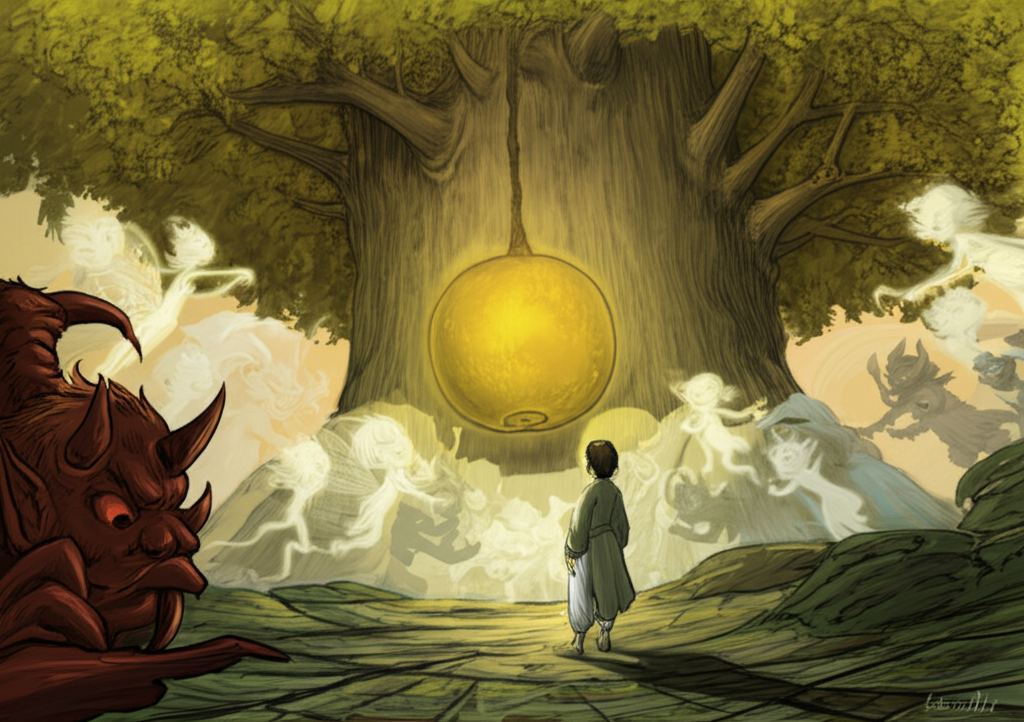
The prince promised to do everything the fakir said. He rode for a week and got to the fairies’ land. He blew the dirt off his hand, just like the fakir told him, and became invisible! He rode through the big garden to the open field. There he saw the bél-tree with the single fruit hanging all alone. He threw the fakir’s stick at it and caught it in the corner of his blanket as it fell. But then, he wasn’t invisible anymore! All the fairies and demons could see him, and they came running after him as he rode away, yelling at him. He looked behind him, and poof! He and his horse turned into stone! The bél-fruit went back to its tree and hung itself back up.
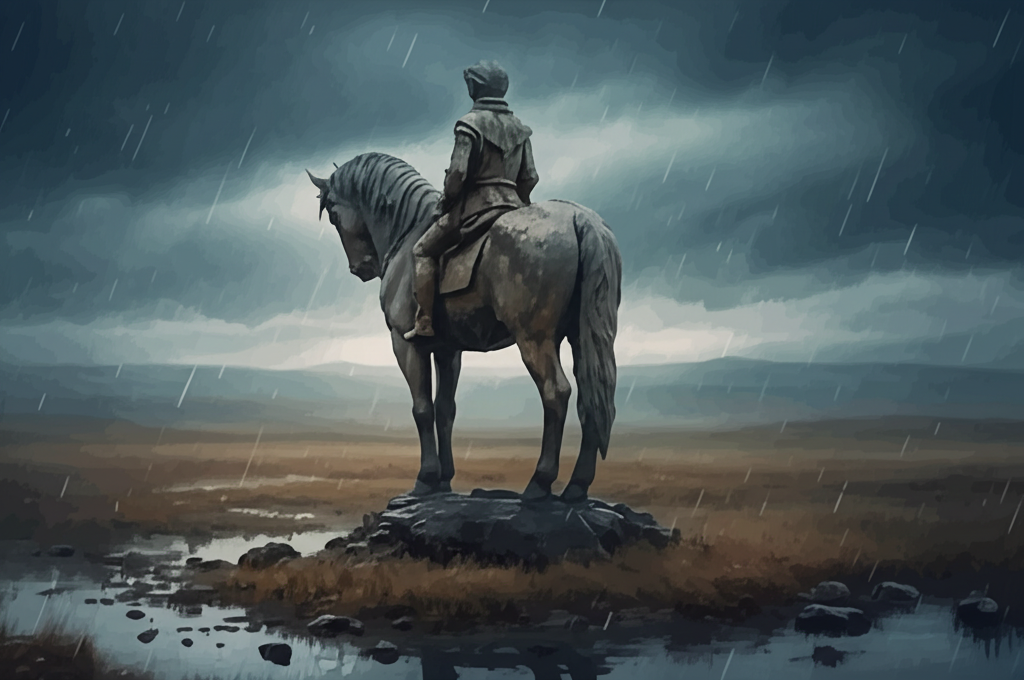
The fakir waited in his jungle for the King’s son for a week. But the moment the prince turned into stone, the fakir knew it! He set off for the fairies’ land right away. He walked all through it, but the fairies and demons couldn’t touch him. He went straight to the open field and saw the King’s son sitting on his horse, both turned to stone.
This made the fakir really sad. He said to God, “What will his mom and dad do now that their son is stone?” He prayed to God, “If it’s your will, please let this King’s son live again!” Then he cut his pinky finger and smeared the prince’s forehead with the blood. He rubbed some blood on the horse too, praying to God to bring them back to life. And just like that, the King’s son and his horse were alive again! The fakir took the prince back to his jungle and said, “Listen! I told you not to look behind you! You didn’t listen, and you turned into stone! If I hadn’t come to save you, you would have stayed that way forever!”
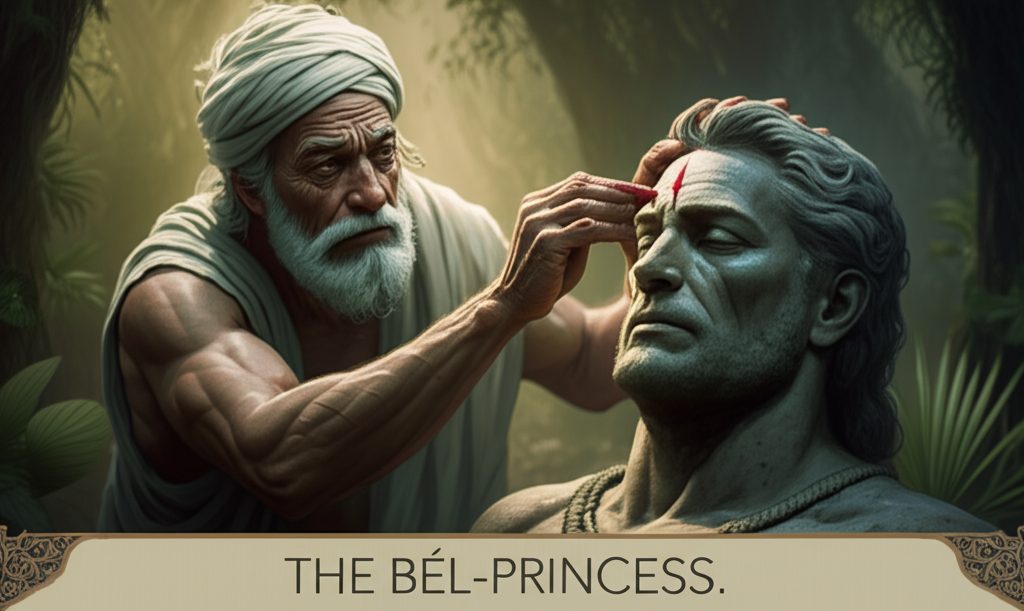
The fakir kept the prince with him in the jungle for a whole week. Then he gave him his stick and some dirt from the ground where they were standing. He said, “Now you have to go to the fairies’ land again. Throw my stick at the bél-fruit and catch it in your blanket, just like before. But this time, remember: don’t look behind you! If you do, you’ll turn to stone and stay that way forever! Ride straight back to me with the fruit and don’t look back even once!”
So the King’s son went to the fairies’ land again. Everything happened just like before until he caught the fruit in his blanket. This time, he rode straight back to the fakir without looking behind him, even though the fairies and demons chased him and yelled at him the whole way!
He rode so fast they couldn’t catch him. When he got to the fakir, the fakir turned him into a fly and hid him! The fairies and demons showed up and shouted, “There’s a thief in your house!” “A thief? Where?” the fakir asked. “Look everywhere and take him away if you find him!” They searched and searched but couldn’t find the prince. Finally, they gave up and left.
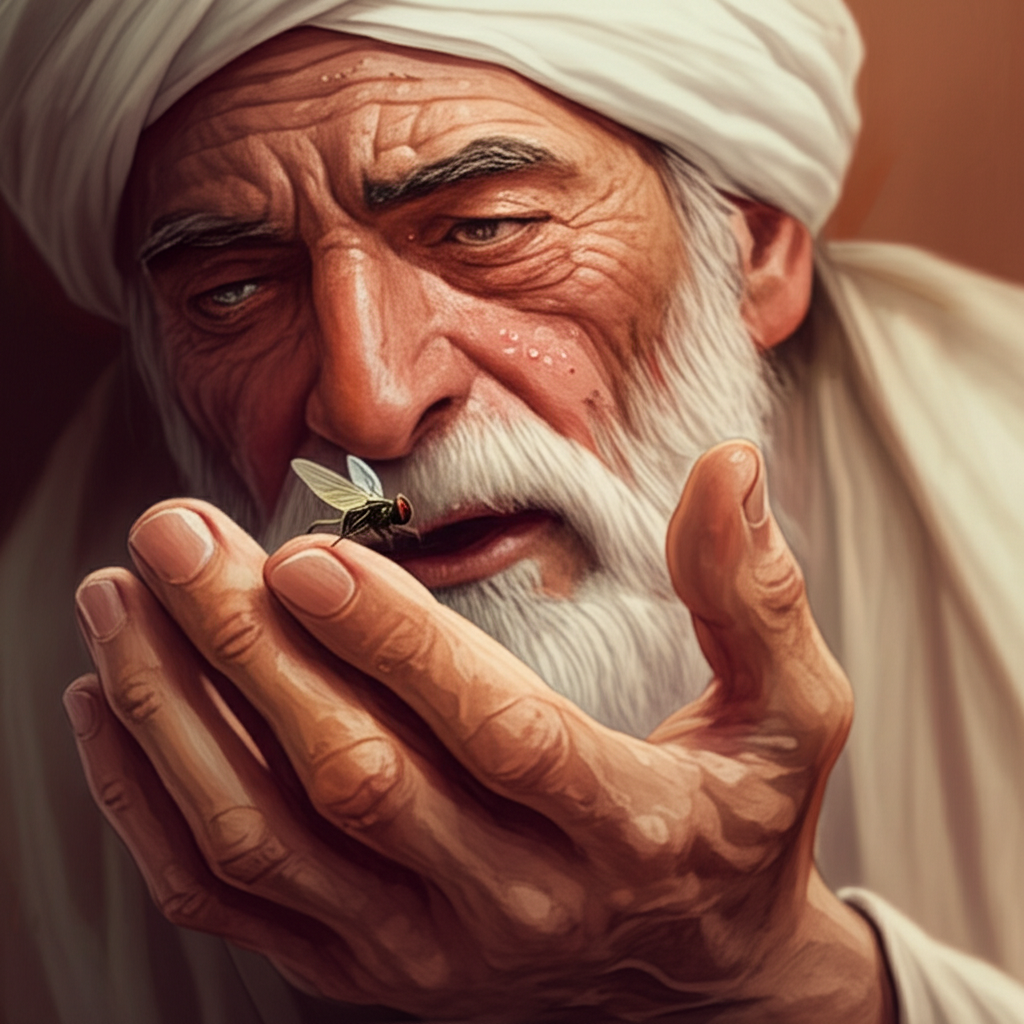
Once they were gone, the fakir turned the little fly back into a King’s son. A few days later, he said to the prince, “You got what you wanted! You have the Bél-Princess you were looking for. Now go back to your mom and dad!” “Okay,” said the prince. He got his horse ready, grabbed the bél-fruit, and said goodbye to the fakir. The fakir said, “Now listen carefully. Don’t open the fruit on the way home! Wait until you’re in your dad’s house with your mom and dad, and then open it. If you don’t do exactly as I say, something bad will happen! Promise you’ll only open the fruit in your dad’s house! The Bél-Princess will come out of it!”
The prince started his journey. He rode and rode for six months until he reached his dad’s kingdom and his dad’s garden. He sat down to rest by a well under some big trees. He thought, “Now that I’m in my dad’s country and garden, I can rest here. Then I’ll go to the palace.” He washed his face and hands in the well and drank some water. Then he thought, “Now that I’m in my dad’s country and garden, I don’t have to wait to open the bél-fruit. What harm could it do if I open it here?”
So, even though the fakir told him not to, he broke the fruit open! Out popped the most beautiful girl! She was so beautiful that the King’s son fainted when he saw her! The princess waved some air at him and poured water on his face. He woke up and said, “Princess, I want to sleep for a bit. I’ve been traveling for six months and I’m super tired. After I sleep, we’ll go to my dad’s palace together.” So he fell asleep, and the princess sat beside him.
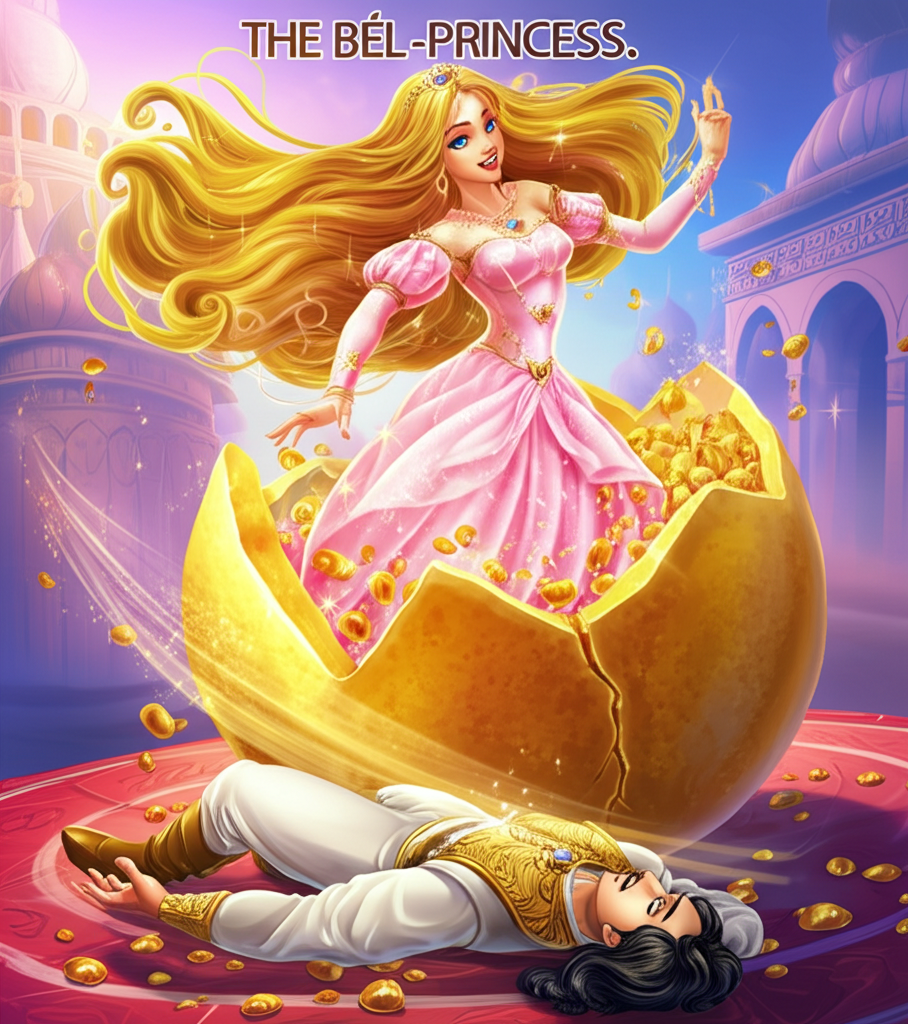
Soon, a woman came to the well for water. She thought, “Wow, that’s the King’s youngest son! And who’s that beautiful princess with him? Look at her fancy clothes and jewelry!” The woman decided to kill the princess and take her place.
She went over to the beautiful girl, sat down next to her, and started talking to her. “Hey princess,” she said. “Let’s trade clothes! Give me yours, and I’ll give you mine.” The princess, thinking it was just a game, did what the woman said. “Now,” said the woman, “let me wear your beautiful jewelry!” The princess gave her the jewelry. Then, the mean woman said, “Let’s walk around the garden and look at the flowers!” After a while, she said, “Princess, let’s look at ourselves in the well! You can see what you look like in my clothes, and I can see what I look like in yours!” The young girl agreed, and they went to the well. As they leaned over to look in, the mean woman pushed the princess into the water!
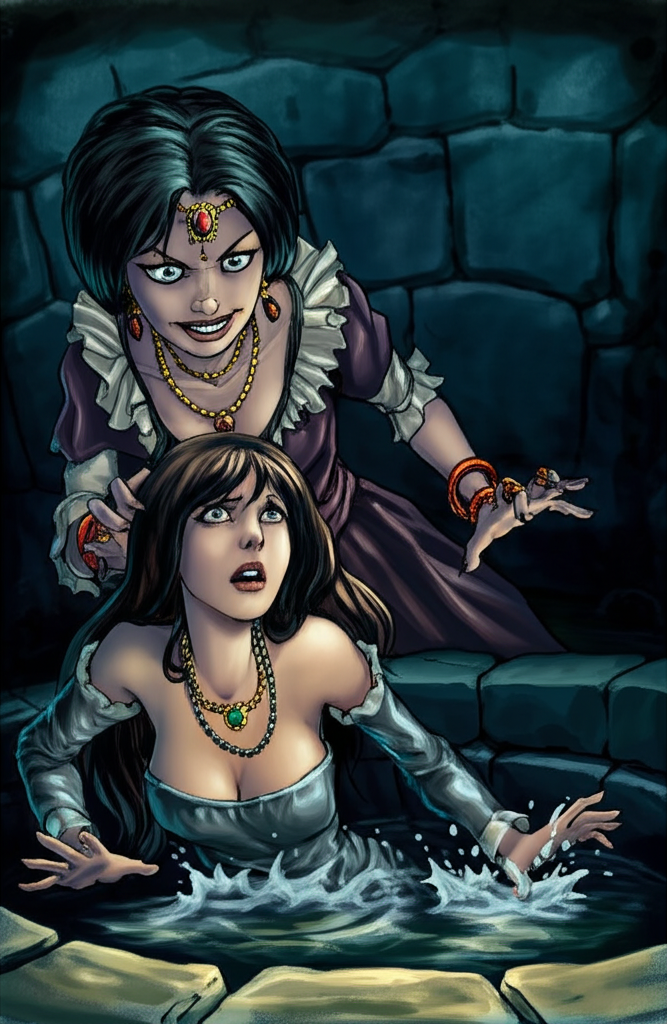
Then she went and sat down by the sleeping prince, just like the princess had. When he woke up and saw the ugly, mean woman instead of his Bél-Princess, he was super confused! He thought, “A minute ago, there was a beautiful girl here, and now there’s this ugly woman! She’s wearing the clothes and jewelry that my Bél-Princess wore, but she’s so ugly, and something’s wrong with her eye! What happened?” He asked the mean woman, who he thought was his Bél-Princess, “What’s wrong with you? Why did you get so ugly?” She answered, “I’ve always lived inside a bél-fruit. The bad air in your country made me ugly and hurt my eye!”
The prince was embarrassed and super sad. He thought, “How can I take her to my dad’s palace now? My mom and all my brothers’ wives will see her! What will they say? Oh well, I have to take her to my house and marry her. I can’t imagine what happened to her!” He got a special chair called a palanquin and took her to the palace.
His mom and dad were happy he was home, but when they saw the mean woman and heard she was his Bél-Princess, they said, “Is she really a Bél-Princess? She’s not pretty or nice!” “She was beautiful when she came out of the fruit!” said the prince. “I don’t know what happened to her. The bad air in this country must have made her ugly.” Then he told them about his trip to the jungle, how he met the fakir, and how he found the Bél-Princess, and how he opened the fruit in his dad’s garden and fell asleep.
The King threw a big wedding party for his son. He and the mean woman got married, and the King’s youngest son thought he was marrying the Bél-Princess.
Meanwhile, the beautiful girl hadn’t drowned in the well. She turned into a beautiful pink lotus flower! A man from the village who came to the well for water saw the flower. “What a beautiful lotus flower!” he said. “I have to pick it!” But when he tried to grab it, the flower floated away! He told everyone in the village about the flower, and then the palace servants heard about it. They all tried to pick it, but the flower always moved just out of reach. The King and his six sons heard about it and came to the well, but they couldn’t pick it either! The lotus flower always floated away from them.
Finally, the youngest prince heard about the lotus and wanted to see it. “I’ll try to pick it,” he said. “I’ll try to touch the flower that no one else can touch!” He came to the well, leaned over, and reached out his hand. The second he did, the flower floated right into his hand!
He was super happy and proud! He took the flower to his wife and showed it to her. “Look!” he said. “Everyone was talking about this flower and trying to pick it. My dad tried, and my brothers tried, but the flower wouldn’t let anyone touch it! As soon as I reached out, it floated right into my hand!”
When his mean wife saw the flower, she didn’t say anything, but she knew it was the beautiful girl she had pushed into the well. The prince put the flower on his pillow and felt happy. As soon as he left, his wife grabbed the lotus flower, tore it into pieces, and threw them in the garden.
In a few days, a bél-tree grew where she had thrown the lotus flower. It grew one big bél-fruit. It was so big and beautiful that everyone in the village and palace tried to pick it, but no one could touch it! The fruit always floated just out of reach. The King and his six sons tried too, but they couldn’t touch it. The youngest prince heard about the fruit and told his wife, “I’m going to see if I can pick this bél-fruit that no one can even touch!” The mean woman knew that the Bél-Princess was inside the fruit, but she didn’t say anything.
The prince went to the bél-tree. The bél-fruit floated into his hand, and he broke it off the tree and brought it home to his wife. “Look!” he said. “The bél-fruit let me pick it right away!” He was proud and happy. He put the fruit on a table in his room.
When he left, the mean wife took the fruit and threw it in the garden. That night, the fruit burst open, and inside lay a tiny baby girl! The gardener was walking around the garden early in the morning and found the baby. He wondered who had thrown away the fruit and who the baby could be. She was so tiny and pretty! The gardener was super happy because he didn’t have any children. He thought God had finally sent him a child.
He picked her up and took her to his wife.
“Look!” he said. “We’ve never had any children, and now God has sent us this beautiful little girl!” His wife looked at the child and was as happy as he was. “Yes,” she said, “God sent us this child! She’s so beautiful! I’m so happy! But I don’t have any milk for her. If only I had milk, I could feed her and she would live!” The gardener’s wife was sad that she didn’t have milk for the baby.
Her husband said, “Let’s ask God to send you milk!” So they prayed to God. God was happy with them and sent the gardener’s wife lots of milk!
The little girl lived in the gardener’s house. He and his wife took care of her and were happy to have a child. She grew quickly and became lovelier every day! She was more beautiful than any girl anyone had ever seen. Everyone in the King’s country said, “The gardener’s daughter is so lovely! She’s more beautiful than any princess!”
The King’s youngest son’s mean wife heard about the child. She knew it was the Bél-Princess. She didn’t say anything, but she often thought about how to get her killed.
One day, when the gardener’s daughter was seven years old, she was in her dad’s garden, making her own little garden near the house. While she was busy with her flowers, the mean woman’s cow walked into the garden and started eating the plants! The little girl pushed the cow out of the garden because she didn’t want it to eat her dad’s flowers.
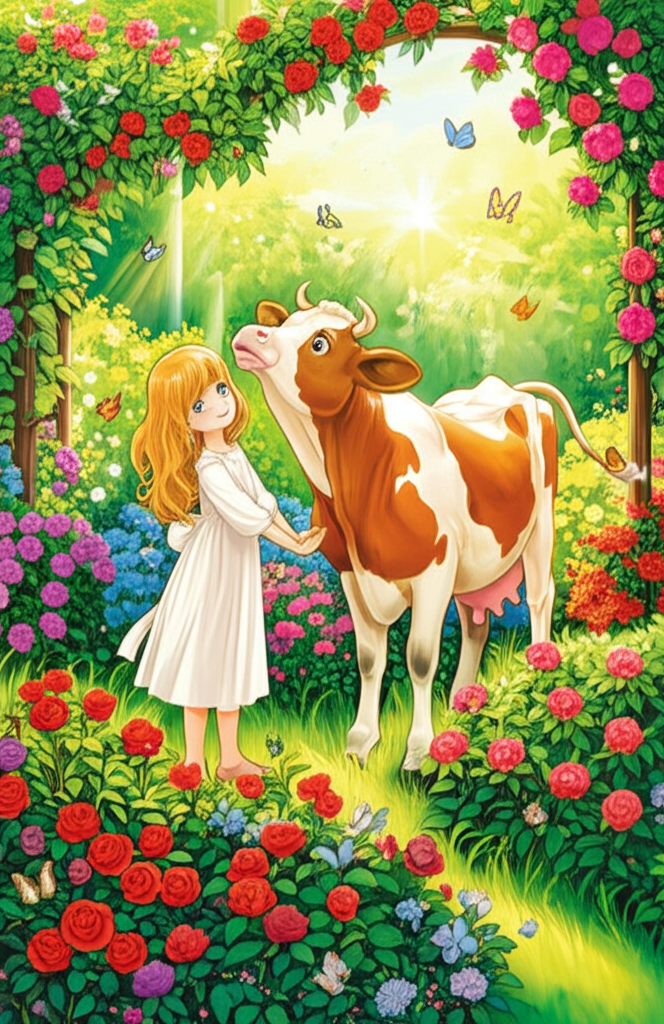
The mean woman heard what the gardener’s daughter had done to her cow. She cried all day and pretended to be sick. When her husband asked what was wrong, she said, “I’m sick because the gardener’s daughter hurt my cow! She hit it, turned it out of the garden, and said mean things! If you kill the girl, I’ll get better! If you don’t kill her, I’ll die!” The prince told his servants to take the gardener’s daughter to the jungle the next morning and kill her.
The next morning, the servants went to the gardener’s house to take his daughter away. He and his wife cried and begged the servants to leave the girl with them. They offered them money, saying, “Take this money and leave us our daughter!” “We can’t leave her!” said the servants. “The King’s youngest son told us to take her to the jungle and kill her so his wife can get better!”
They led the girl away. As they went to the jungle, they said, “This girl is so beautiful!” They felt sad about killing her.
They took the girl to a big field about ten miles from the King’s country. They said they couldn’t kill her. She was too beautiful! She said, “You have to kill me. It’s your job.” “No,” they said. “We can’t do it.”
Then the girl took a knife and cut out her eyes! One eye turned into a parrot and the other into another kind of bird. Then she cut out her heart, and it turned into a big pool of water! Her body turned into a fancy palace and garden, even grander than the King’s palace! Her arms and legs became the pillars that held up the porch roof. Her head became the dome on top of the palace!
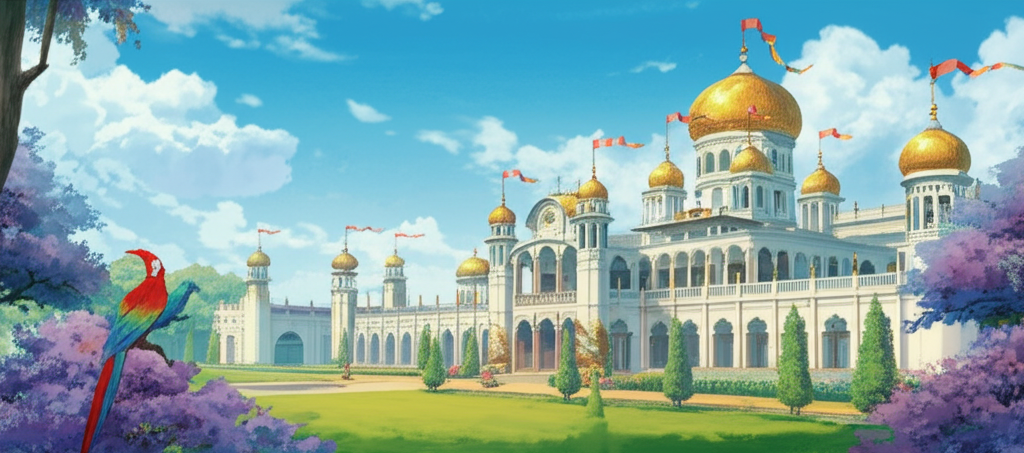
The prince’s servants watched all this happen. They were so scared that they didn’t tell the prince or anyone else what they had seen. No one lived in this amazing house. It stood empty in its garden by its pool, and the parrot and bird lived in the garden trees.
Some time later, the youngest prince went hunting. In the evening, he ended up in the field where the palace stood. He rode up to it and thought, “I’ve never seen this house before. I wonder who lives here?” He went through the gate into the garden and saw the big pool of water and how beautiful the garden was. He went through the garden and was amazed by it. It was clean and perfect!
He went into the palace and through all the rooms, wondering who it belonged to. He was surprised to find no one there, even though the rooms were fancy, clean, and neat.
“My dad is a great king,” he thought, “but he doesn’t have a palace like this!” It was getting dark, so the prince knew he couldn’t go home. “I’ll sleep on the porch,” he said. “I’m not afraid, even though I’ll be alone.”
He lay down to sleep on the porch. The parrot and bird flew in and sat near him. They knew he was there and wanted him to hear what they said. They started chatting. The parrot told the bird that the prince’s father was king of the nearby country and had seven sons. Six of the sons were married, but the youngest son didn’t want to get married, and he didn’t like his brothers’ wives. The birds stopped talking for the night. The prince was surprised the birds knew who he was and about his dislike of his brothers’ wives.
The next morning, he rode home. He stayed inside all day and didn’t talk. His wife asked, “What’s wrong? Why are you so quiet?” “My head hurts,” he answered. “I’m sick.” But in the evening, he had to go back to the empty palace. He told his wife, “I’m going out for some fresh air.” He got on his horse and rode to the palace.
As soon as he lay down on the porch, the parrot and bird sat near him. The parrot told the bird how the prince had heard about the Bél-Princess and about his long journey to find her. He told about finding the bél-fruit and how he was turned to stone. Then the birds stopped talking.
In the morning, the King’s son rode home, quiet and serious. He told his wife his head hurt when she asked if he was sick.
That night, he slept on the porch of the strange palace again and heard a little more of his story from the birds.
The next day, he was still quiet, and his wife was worried. “I think the Bél-Princess is alive,” she said to herself, “and he goes every night to see her.” She asked him, “Why do you go out every evening? Why don’t you stay home?” “I’m not well,” he answered. “I’m going to my mom’s house” (the prince had a small house of his own in his father’s yard). “I won’t sleep at home again until I feel better.”
That night, he slept on the porch of the empty palace again and heard the parrot tell the bird everything that had happened to the prince up to the time he fell asleep in his father’s garden with the beautiful Bél-Princess sitting next to him.
On the fifth night, the prince lay down to sleep on the porch of the palace and waited for the little birds to start talking. The parrot told how the mean woman had taken the Bél-Princess’s clothes and thrown her down the well, how the princess became a lotus flower that the wife broke into pieces, how the pieces turned into a bél-fruit that she threw away, and how a baby girl came out of the fruit and the gardener took care of her. The parrot told how the mean woman had made the prince kill the girl when she was seven years old, how he and the bird had been the girl’s eyes, how the pool had been her heart, and how her body had become the palace and garden, while her head became the dome on top of the palace.
Then the bird asked where the Bél-Princess was. “Can’t she be found?” the bird asked. “Yes,” said the parrot. “The King’s youngest son has to find her, but he’s so silly! He believes that his ugly, mean wife is the beautiful Bél-Princess!” “Where is the princess?” asked the bird. “She’s here!” said the parrot. “If the prince went through all the rooms in the palace until he got to the center room, he’d see a trap door in the middle of the floor. He can lift the trap door and see a staircase that goes to an underground palace, and the Bél-Princess is in that palace!” “Can anyone else lift the trap door?” the bird asked. “No,” answered the parrot. “Only the King’s youngest son can lift the trap door and find the Bél-Princess.”
The next day, the young prince went through all the rooms in the palace instead of going home. When he got to the center room, he looked for the trap door. When he lifted it, he saw the staircase. He went down and found himself in the underground palace. It was even more beautiful than the palace above ground! It was full of servants! In one room, a fancy dinner was ready. In another room, he saw a golden bed covered with pearls and diamonds. The Bél-Princess was on the bed!
Day and night, she prayed to God and read a holy book. She did nothing else.
When the prince went into her room, she felt sad because she thought, “He’s so silly. He doesn’t know anything about what happened to me.”
She said to him, “Why did you come here? Go home to your dad’s palace.”
The prince started to cry. “Princess,” he said, “I didn’t know about your palace! I found it by accident five nights ago. I’ve been sleeping here on the porch for the last five nights, and I only learned about what happened to you last night and how to find you!” “I know you didn’t know,” she said. “Now that you’ve found me, what will you do?”
“I’ll go home to my dad’s palace,” he answered, “and get everything ready for you. Then I’ll come back, and we’ll get married, and I’ll take you home.”
They made a plan. He ate some food and went back to his father. He told his mom and dad everything that had happened to the Bél-Princess, how her body had turned into the beautiful garden and palace, how the little birds told him, and how she was living in the underground palace. His father said that he, the prince’s mother, and his brothers and wives would all take him to the palace and help him get married to the beautiful Bél-Princess. Then they would all go back to their own palace and live together. “But first, we have to kill the mean woman!” said the King.
He told his servants to take her to the jungle, kill her, and throw her body away. They took her away in the afternoon and killed her.
Two or three days later, the prince, his mom and dad, and his brothers and sisters-in-law went to the big palace. In the evening, the king’s youngest son married the Bél-Princess. When his mom and dad and brothers and wives saw her, they all said, “It’s true! She really is a Bél-Princess!”
After the wedding, they all went back to the King’s palace and lived together. The King and his sons would often go to the palace for fresh air, and they would let other kings and queens visit too.